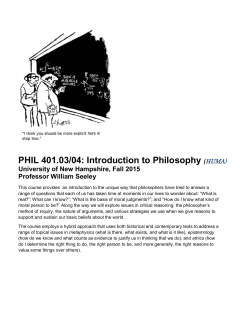
THE OMEGA PRINCIPLE part 1
THE OMEGA PRINCIPLE THE ENERGY WHICH PATTERNS RANDOMNESS by Dr. Richard Alan Miller, c1974, 2015 www.richardalanmiller.com www.oak-publishing.com Part One: On the Nature of Metaphysics Within the field of parapsychology there exists the growing belief that we are now on the verge of discovering a "new force" in nature. This "new force" is generally unrecognized by conventional science, but throughout history accounts of a strange luminous energy run like a silver thread through ancient occult and spiritual traditions. It has become called many names: animal magnetism, orgone, mana, prana, life force and the like (see appendix for complete list). I believe that an important key to understanding this new force or "energy," in reference to our present technology and sociology, resides in the study of these ancient and spiritual traditions. Physical Theory One of man's most persistent and revealing preoccupations has been his attempt to fashion for himself an adequate conceptual model of the Universe. We can trace the beginning of our development in science to the imaginative minds of the great Greek thinkers. Physical theory is usually built on observable and measurable phenomena. It concerns itself with the uniformity of behavior underlying the apparent irregularities and then expresses itself in the language of number and geometry. Plato (427-347 B.C.), however, held that physical laws can be found from directly intuitive principles, the aim being to explain specific phenomena in the context of a philosophic system. The truth of a principle was not measured, as it is today, by its usefulness in every conceivable known or predicted physical system. As Plato states in his Phaedo: "This was the method I adopted: I first assumed some principle, which I judged to be the strongest, and then I affirmed as true whatever seemed to agree with this, whether relating to the cause or to anything else; and that which disagreed I regarded as untrue." The Greeks thought that metaphysics was easier than physics, and tended to deduce scientific principles from a priori conception of the nature of things. Metaphysics was the discipline which studied principles of knowledge or of being in terms of intuitive, self-evident concepts, concepts of direct "everyday" experience and analogies. Thus, physical theory to the Greeks was intelligible only in the context of a prior specific metaphysical theory. It was not until the 16th and 17th centuries, after the great struggle of falling bodies, that these doctrines were abandoned in favor of the experimental sciences. The apparent reasons for the careful separation of metaphysics from scientific thought are purely practical; namely, we can agree about science....after due debate....whereas in metaphysics debate usually accentuates disagreement. These characteristics of science and metaphysics were unrecognized in the early days of civilized thought. It should be noted at this time an example of an important human trait which colors all scientific work and which even the greatest thinkers can never hope to overcome entirely....we all tend to deny the importance of facts or observations not in accord with our convictions and preconceptions. We sometimes ignore them altogether, even though, from another point of view, they stand before our very eyes. Even the most general and modern scientific theory does not hope or even seriously attempt to accommodate every single detain of a specific case. One is always forced to idealize the observations before attempting a match between "facts" and theory....not only because there are usually unavoidable experimental uncertainties in observations, but because conceptual schemes are consciously designed to apply to selected observations rather than to the totality or raw experience. As a consequence, the history of science is studded with cases in which it turned out too late that the neglected part of a phenomenon was actually its most significant aspect. Concept of Energy Today we define "energy" in modern textbooks as the "ability to do work." When a force acts against resistance to produce motion in a body, the force is said to do the work. Work is measured by the product of the force acting and the distance moved against the resistance. To complete this mess, a definition for force is needed. Force is usually now defined as "that which changes the state of rest or motion in matter, measured by the rate of change of momentum. In more general and simplified terms, "energy" is the ability to do "something" or overcome some "resistance." Today's classical sciences has four generally recognized forms of energy. There are electromagnetic (EM), nuclear binding (short distances), neutron decay or weak energy (the force which holds the neutron together), and gravity. There are many different areas where these types of "energies" are observed but when new observations are made which do not include any of the above energies, these observations are usually either ignored or considered in error. Toward the end of the nineteenth century the discovery of x-rays and other "invisible" radiation prompted doctors to wonder whether the concept of a "life energy" might not be a valid way of approaching health and healing. The phenomena known as "the laying on of hands" is perhaps the most common example of some force other than electromagnetic fields somehow interacting and causing changes in biological processes. Historically, the process of healing by the imposition of hands was first mentioned in Ebers Papyrus, 1552 B.C. Today we still have excellent examples of this "new energy," causing much re-evaluation on our whole concept of energy in general. Franz Anton Mesmer It is impossible to give a satisfactory definition of this new force but several examples where this concept is used might be useful. The most classic was that of Franz Anton Mesmer, M.D. (17731815). After acquiring his Ph.D. in Philosophy, Mesmer studied Medicine at the University of Vienna, graduating in 1766. His thesis topic: "The Influence of the Planets in the Cure of Disease." Mesmer drew freely upon the magnetic fluid theory reported by such alchemistphysicians of the preceding two centuries such as Paracelsus, Van Helmont and Robert Fludd. The fluid, which supposedly permeated all space, was said to sympathetically link all beings, inanimate objects and the stars: "Ye grant that material nature doth daily draw down forces by its magnetism from the Superior Orbs....and that the heavens do in exchange invisibly allure something from the inferior bodies, that there may be a free and mutual passage and a harmonious concord of the members of the universe. "How, by relation of natural things unto one another, they do, after a corporal contact or touch is made between them, operate wonderfully, and that by a magnetically concent and Spiritual Continuity....by a mutual operation at an unknown distance." (1) Mesmer condensed his theories into 27 major postulates, the knowledge of which would constitute a new departure in Physics and universal means of healing and preserving men. Mesmer termed this new force "Animal Magnetism." A study of his theory of Animal Magnetism yields a notion very similar to that of mana held by the Malanesians. ---------------------------------------------------------(1) Horton, Gerald, Introduction to Concepts and Theories in Physical Sciences. AddisonWesley Publishing Co., Cambridge, MA, c1953. Next Month: Part Two: Religion and Faith Healers Dr. Richard Alan Miller Physicist and Writer www.richardalanmiller.com/ram/ www.oak-publishing.com 02-18-15 Words: 1,153
© Copyright 2025











